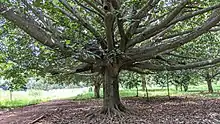Ficus drupacea var. pubescens
Ficus drupacea var. pubescens, also known as the Mysore fig (named for Mysore, India) or brown woolly fig,[2] is a variety of F. drupacea distinguished by its fruits and leaves having a dense yellow-brown pubescence.[3][4] It is naturally distributed throughout Southeast Asia, and has been introduced elsewhere.[3] It forms a distinct shape with large, buttressing roots. Its leaves are characterized by a distinctly pointed tip, and it is pollinated by small wasps.[5]
| Ficus drupacea var. pubescens | |
|---|---|
 | |
| Scientific classification | |
| Kingdom: | Plantae |
| Clade: | Tracheophytes |
| Clade: | Angiosperms |
| Clade: | Eudicots |
| Clade: | Rosids |
| Order: | Rosales |
| Family: | Moraceae |
| Genus: | Ficus |
| Species: | |
| Variety: | F. d. var. pubescens |
| Trinomial name | |
| Ficus drupacea var. pubescens (Roemer & Schultes) Corner | |
| Synonyms[1] | |
| |
It has been introduced and popularly recognized for its size and form in various locations, including in Florida, its root systems reaching 30 feet (9.1 m) or more in diameter.[6] However, the shallow base of the roots (~12 inches (300 mm)[7]) has led to susceptibility during hurricanes.[6][8][9] Well-known individuals are or were located on the Edison and Ford Winter Estates in Fort Myers, Florida (uprooted by Hurricane Irma in 2017), 80 feet (24 m) tall and 30 feet (9.1 m) wide,[6][8][9] and Estero, Florida. The latter is currently living and is the largest individual in Florida (Florida State Champion), planted in 1896 from Mysore, India, standing at 95 feet (29 m), with a 133 foot (41 m) crown spread and 40 foot (12 m) circumference.[10][11][12][13]
References
- "Tropicos | Name - Ficus drupacea var. Pubescens (Roth) Corner".
- "Brown Woolly Fig - Ficus drupacea var. pubescens - Overview - Encyclopedia of Life". Encyclopedia of Life. Retrieved 2018-07-20.
- "Ficus drupacea var. pubescens in Flora of China @ efloras.org". www.efloras.org. Retrieved 2018-07-20.
- "Ficus drupacea - MORACEAE". www.biotik.org. Retrieved 2018-07-20.
- "Arboretum Images 10b". www2.palomar.edu. Retrieved 2018-07-20.
- "Wood from felled Mysore fig tree at Edison estate is for sale | Charlotte County Florida Weekly". Charlotte County Florida Weekly. 2018-07-12. Retrieved 2018-07-20.
- Bolton, Tamra. "Edison & Ford Winter Estates — A Behind the Scenes Look at Two American Geniuses". Parade. Retrieved 2018-07-20.
- "Before and After Irma: Edison Ford Winter Estates popular Mysore Fig tree in Fort Myers". The News-Press. Retrieved 2018-07-20.
- "Positively SWFL: Uprooted by Irma, iconic tree gaining new life". Retrieved 2018-07-20.
- "Choreographed Christmas lights dance around champion tree". The News-Press. Retrieved 2018-07-20.
- "Estero's Champion Tree | Spotlight News Magazine". Southwest Spotlight. 2013-11-16. Retrieved 2018-07-20.
- "Village Council and staff continue to work closely with community post-Hurricane Irma – Village of Estero, FL". estero-fl.gov. 2017-09-18. Retrieved 2018-07-20.
- "Mysore Fig Tree - Home". www.mysorefigtree.com. Retrieved 2018-07-20.